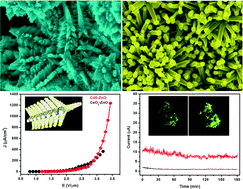Decoration of CdS nanoparticles on 3D self-assembled ZnO nanorods: a single-step process with enhanced field emission behaviour
Abstract
A well-defined CdS–ZnO heteroarchitecture has been synthesized via a facile single-step hydrothermal approach. The morphological and structural studies reveal the formation of 3D nano-architectures, in which self-assembled ZnO nanorods (diameter ~50 nm) are well decorated with single crystalline CdS nanoparticles (size ~10 nm). The CdS–ZnO heteroarchitecture exhibits a remarkable change in the optical absorption due to the surface modification of ZnO nanorods by CdS. Surprisingly, under identical reaction conditions, the global ZnS nanoparticles are selectively grown at the apex of ZnO nanorods on the Zn substrate. Furthermore, a plausible growth mechanism has been presented on the basis of experimental results. Interestingly, the CdS–ZnO heteroarchitecture shows enhanced field emission properties such as low turn-on field, high emission current density and better current stability in comparison to other ZnO-based nanostructures. The present CdS–ZnO heteroarchitecture could be extended to other potential applications, such as chemical sensors, photodetectors, optoelectronic devices, and photocatalysts.


 Please wait while we load your content...
Please wait while we load your content...